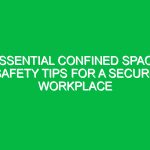Welcome to the Toolbox Talk
Hello everyone, and thank you for gathering today for our Toolbox Talk on a very important topic: Silica Dust. As we prepare to start our work, it’s crucial that we understand the risks associated with silica dust and how we can protect ourselves and each other on the job. Today, we’ll cover what silica dust is, the health risks it poses, how to identify it, and the Best Practices for minimizing exposure. Let’s dive in!
Understanding Silica Dust
Silica dust is a common mineral found in materials like sand, stone, concrete, and mortar. When these materials are disturbed—through processes such as cutting, grinding, drilling, or crushing—tiny particles of silica dust become airborne. These particles are so small that they can easily be inhaled, leading to serious health issues. In fact, silica is one of the most common occupational Hazards in many industries.
Health Risks Associated with Silica Dust
Exposure to silica dust can have severe health implications. The most serious condition linked to silica exposure is silicosis, a lung disease that can develop after prolonged inhalation of silica particles. Symptoms may include:
- Coughing
- Shortness of breath
- Fatigue
- Chest pain
Long-term exposure can also increase the risk of lung cancer, chronic obstructive pulmonary disease (COPD), and other respiratory issues. Understanding these risks is vital for maintaining a safe work Environment.
Identifying Silica Dust Hazards
It’s essential to recognize where silica dust might be present in our workplace. Common sources of silica dust include:
- Construction activities (e.g., cutting concrete, brick, and stone)
- Mining and quarrying
- Manufacturing (especially glass and ceramics)
- Demolition work
If you are involved in any of these activities, it’s important to assess the risk of silica dust exposure. Always be aware of your surroundings and the materials you are working with.
Best Practices for Minimizing Exposure
Now that we understand the risks, let’s discuss how to keep ourselves safe from silica dust while working. Here are some practical guidelines to follow:
Use Engineering Controls
Whenever possible, implement engineering controls to reduce silica dust exposure. This might include:
- Wet methods: Use water to suppress dust when cutting or grinding materials.
- Ventilation: Ensure proper ventilation in work areas to keep dust levels down.
- Enclosures: Use dust collection systems or enclosures to contain dust.
Personal Protective Equipment (PPE)
In addition to engineering controls, wearing the right PPE is crucial. Always use:
- Respirators that are rated for silica dust
- Protective eyewear to shield against flying particles
- Dust masks designed to filter silica particles
Make sure to regularly inspect and maintain your PPE to ensure it remains effective.
Safe Work Practices
Implement safe work practices to further reduce exposure:
- Limit the time you spend working in dusty environments.
- Take regular breaks in clean areas to minimize the inhalation of silica dust.
- Clean up work areas regularly and properly dispose of any dust and debris.
Real-Life Scenarios
Let’s consider a few scenarios that might occur in our work environment:
Scenario 1: Cutting Concrete
Imagine you are tasked with cutting concrete for a new foundation. Without using water or a dust collection system, silica dust will be generated, putting you at risk. By using water to wet the surface while cutting, you significantly reduce the amount of airborne dust, making the environment safer for yourself and your coworkers.
Scenario 2: Demolition Work
During a demolition project, you notice a lot of dust in the air. If you are wearing a regular mask that is not rated for silica dust, you might still be at risk. This is a reminder to always wear the appropriate respirator and ensure that all team members follow the same Safety Standards.
Regulations and Standards
It’s important to be aware of the Regulations surrounding silica dust. The Occupational Safety and Health Administration (OSHA) has set permissible exposure limits (PELs) for silica dust to protect workers. Compliance with these regulations is not just a legal obligation; it’s a commitment to Safety and health in the workplace. Regular Training and monitoring can help ensure we adhere to these standards.
Open Discussion
Before we wrap up, I’d like to open the floor for questions or discussions. Here are a few prompts to consider:
- Have you encountered any situations involving silica dust on the job?
- What strategies do you think could help us minimize exposure further?
- Are there any additional resources or training you feel would benefit our team?
Feel free to share your thoughts, as your experiences can help enrich our understanding and approach to managing silica dust safely.
Conclusion
To summarize, silica dust poses serious health risks that we must take seriously. By understanding what silica dust is, recognizing the potential hazards, and implementing Best Practices, we can protect ourselves and our coworkers. Remember to always use engineering controls, wear appropriate PPE, and follow safe work practices.
Thank you for your attention and commitment to safety. Let’s continue to work together to maintain a safe working environment free from the dangers of silica dust.


